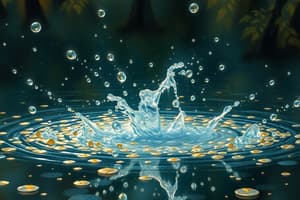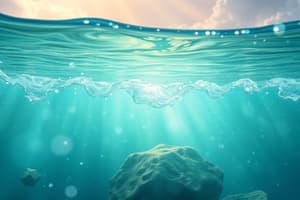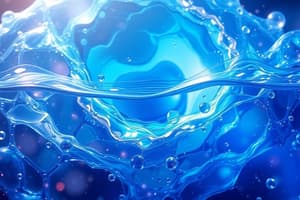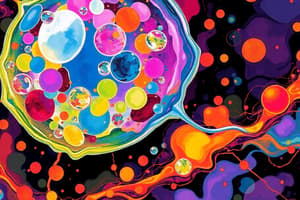Podcast
Questions and Answers
What phenomenon allows water to rise in narrow tubes?
What phenomenon allows water to rise in narrow tubes?
- Viscosity
- Capillarity (correct)
- Diffusion
- Solubility
Why does water have a high thermal capacity?
Why does water have a high thermal capacity?
- Due to its high density
- Because it readily forms ionic bonds
- Due to hydrogen bonding (correct)
- Because of its low viscosity
What is the relationship between hydrogen bonds and temperature regulation in organisms?
What is the relationship between hydrogen bonds and temperature regulation in organisms?
- Hydrogen bonds allow rapid temperature changes.
- Hydrogen bonds have no impact on temperature regulation.
- Hydrogen bonds help prevent temperature fluctuations. (correct)
- Hydrogen bonds cause temperature to rise rapidly.
What is the heat of vaporization for water at its boiling point?
What is the heat of vaporization for water at its boiling point?
How does water conduct heat throughout an organism?
How does water conduct heat throughout an organism?
What is the primary reason water requires significant heat energy to raise its temperature?
What is the primary reason water requires significant heat energy to raise its temperature?
What role does water's high heat capacity have for enzymes in biological processes?
What role does water's high heat capacity have for enzymes in biological processes?
What happens as water moves up a tube due to capillarity?
What happens as water moves up a tube due to capillarity?
What effect does sweating and panting have on body temperature?
What effect does sweating and panting have on body temperature?
At what temperature is water densest?
At what temperature is water densest?
Why is ice less dense than liquid water?
Why is ice less dense than liquid water?
What is the pH range that is considered neutral?
What is the pH range that is considered neutral?
What happens when pure water is added to an acidic solution?
What happens when pure water is added to an acidic solution?
Which of the following describes an acid?
Which of the following describes an acid?
How does the freezing of water help aquatic life during the winter?
How does the freezing of water help aquatic life during the winter?
Which of the following statements about hydrogen bonds in water is true?
Which of the following statements about hydrogen bonds in water is true?
What happens to the pH of a solution when pure water is added to a base?
What happens to the pH of a solution when pure water is added to a base?
What role do buffers play in biological systems?
What role do buffers play in biological systems?
Which of the following is true regarding mixtures in nature?
Which of the following is true regarding mixtures in nature?
In the context of dispersion systems, what defines a solution?
In the context of dispersion systems, what defines a solution?
Which characteristic distinguishes a true solution from other mixtures?
Which characteristic distinguishes a true solution from other mixtures?
Which of the following is NOT a component of biological solutions?
Which of the following is NOT a component of biological solutions?
What does the concentration of solutes in biological fluids indicate?
What does the concentration of solutes in biological fluids indicate?
Which of the following can act as either a solvent or a solute?
Which of the following can act as either a solvent or a solute?
Which monosaccharide is absorbed most rapidly and completely?
Which monosaccharide is absorbed most rapidly and completely?
What is the primary effect of glucose and galactose on blood sugar levels?
What is the primary effect of glucose and galactose on blood sugar levels?
What type of bond joins two monosaccharides to form a disaccharide?
What type of bond joins two monosaccharides to form a disaccharide?
Which of the following is a disaccharide formed from glucose and fructose?
Which of the following is a disaccharide formed from glucose and fructose?
Which disaccharide is known as table sugar?
Which disaccharide is known as table sugar?
What reaction occurs when two monosaccharides combine to form a disaccharide?
What reaction occurs when two monosaccharides combine to form a disaccharide?
Why is sucrose considered a non-reducing sugar?
Why is sucrose considered a non-reducing sugar?
What is the primary component of maltose?
What is the primary component of maltose?
What type of bond is formed between the carboxyl group of one amino acid and the amino group of another?
What type of bond is formed between the carboxyl group of one amino acid and the amino group of another?
Which level of protein structure refers to the specific linear sequence of amino acids?
Which level of protein structure refers to the specific linear sequence of amino acids?
What type of secondary structure is characterized by hydrogen bonding forming a spiral shape?
What type of secondary structure is characterized by hydrogen bonding forming a spiral shape?
Which of the following describes the tertiary structure of a protein?
Which of the following describes the tertiary structure of a protein?
Which of the following is NOT a major type of secondary structure in proteins?
Which of the following is NOT a major type of secondary structure in proteins?
What primarily influences the interactions that stabilize the tertiary structure of a protein?
What primarily influences the interactions that stabilize the tertiary structure of a protein?
What type of bond links the sulfur atoms of cysteine residues in a protein's tertiary structure?
What type of bond links the sulfur atoms of cysteine residues in a protein's tertiary structure?
What leads to the formation of a polypeptide chain during protein synthesis?
What leads to the formation of a polypeptide chain during protein synthesis?
What is the primary function of haemoglobin in the blood?
What is the primary function of haemoglobin in the blood?
Which of the following correctly describes the structure of collagen?
Which of the following correctly describes the structure of collagen?
What is the role of the haem group in haemoglobin?
What is the role of the haem group in haemoglobin?
What component forms the backbone of triglycerides?
What component forms the backbone of triglycerides?
What distinguishes saturated fatty acids from unsaturated fatty acids?
What distinguishes saturated fatty acids from unsaturated fatty acids?
What is the main characteristic of lipids compared to carbohydrates?
What is the main characteristic of lipids compared to carbohydrates?
What is the positive result of the Sudan IV test for lipids?
What is the positive result of the Sudan IV test for lipids?
How do hydrogen bonds contribute to the structure of collagen?
How do hydrogen bonds contribute to the structure of collagen?
Flashcards
Capillarity of water
Capillarity of water
The upward movement of water within narrow tubes due to hydrogen bonding.
High thermal capacity of water
High thermal capacity of water
Water resists changes in temperature due to strong hydrogen bonds.
Water's heat capacity
Water's heat capacity
Water requires a large amount of heat energy to change its temperature.
Heat of vaporization of water
Heat of vaporization of water
Signup and view all the flashcards
Importance of constant temperature
Importance of constant temperature
Signup and view all the flashcards
Water's high thermal conductivity
Water's high thermal conductivity
Signup and view all the flashcards
Water's role in temperature regulation
Water's role in temperature regulation
Signup and view all the flashcards
Importance of water in plants
Importance of water in plants
Signup and view all the flashcards
Water's Heat of Vaporization
Water's Heat of Vaporization
Signup and view all the flashcards
Cooling Effect of Evaporation
Cooling Effect of Evaporation
Signup and view all the flashcards
Why Sweating Cools Us
Why Sweating Cools Us
Signup and view all the flashcards
Ice Floats
Ice Floats
Signup and view all the flashcards
Ice Insulation
Ice Insulation
Signup and view all the flashcards
pH Scale
pH Scale
Signup and view all the flashcards
Water as a Neutral pH
Water as a Neutral pH
Signup and view all the flashcards
Water's Dilution Power
Water's Dilution Power
Signup and view all the flashcards
What are mixtures?
What are mixtures?
Signup and view all the flashcards
What are solutions?
What are solutions?
Signup and view all the flashcards
Why are solutions important for life?
Why are solutions important for life?
Signup and view all the flashcards
What is a solvent?
What is a solvent?
Signup and view all the flashcards
What is a solute?
What is a solute?
Signup and view all the flashcards
What types of substances can be solvents?
What types of substances can be solvents?
Signup and view all the flashcards
What are homogeneous mixtures?
What are homogeneous mixtures?
Signup and view all the flashcards
What are examples of homogeneous mixtures?
What are examples of homogeneous mixtures?
Signup and view all the flashcards
What are proteins made of?
What are proteins made of?
Signup and view all the flashcards
How do amino acids connect?
How do amino acids connect?
Signup and view all the flashcards
What's a dipeptide?
What's a dipeptide?
Signup and view all the flashcards
What is primary protein structure?
What is primary protein structure?
Signup and view all the flashcards
How does the primary structure impact function?
How does the primary structure impact function?
Signup and view all the flashcards
What is secondary protein structure?
What is secondary protein structure?
Signup and view all the flashcards
What's an alpha helix?
What's an alpha helix?
Signup and view all the flashcards
What's a beta pleated sheet?
What's a beta pleated sheet?
Signup and view all the flashcards
Haemoglobin's Structure
Haemoglobin's Structure
Signup and view all the flashcards
Haemoglobin's Function
Haemoglobin's Function
Signup and view all the flashcards
Collagen's Structure
Collagen's Structure
Signup and view all the flashcards
Collagen's Function
Collagen's Function
Signup and view all the flashcards
Lipid Components
Lipid Components
Signup and view all the flashcards
Saturated vs. Unsaturated Fats
Saturated vs. Unsaturated Fats
Signup and view all the flashcards
Phospholipid Structure
Phospholipid Structure
Signup and view all the flashcards
Steroid Structure
Steroid Structure
Signup and view all the flashcards
Monosaccharide Absorption
Monosaccharide Absorption
Signup and view all the flashcards
Glycemic Index
Glycemic Index
Signup and view all the flashcards
Disaccharide Formation
Disaccharide Formation
Signup and view all the flashcards
Disaccharide - Sucrose
Disaccharide - Sucrose
Signup and view all the flashcards
Non-Reducing Sugar
Non-Reducing Sugar
Signup and view all the flashcards
Disaccharide - Maltose
Disaccharide - Maltose
Signup and view all the flashcards
Function of Amylase
Function of Amylase
Signup and view all the flashcards
Lactose Structure
Lactose Structure
Signup and view all the flashcards
Study Notes
Biochemistry Study Notes
- Biochemistry is the study of the chemical processes within and relating to living organisms.
- Living organisms share a common chemistry which provides indirect evidence for evolution.
- Cells of living organisms contain a few groups of carbon-based compounds that interact in similar ways.
- Four major classes of biomolecules: carbohydrates, lipids, proteins, and nucleic acids
- Carbohydrates are a common respiratory substrate and form structural components of cell walls and plasma membranes.
- Lipids have many functions including forming plasma membranes, hormones and respiratory substrates.
- Proteins form many cellular structures, act as enzymes, chemical messengers and are components of blood.
- Nucleic acids carry the genetic code for protein production, common in all living organisms and providing evidence for evolution.
- Water is the most common component of cells.
Water and Mixtures
- Water is crucial to life processes.
- Water's structure (polarity, size, angle of bonds, hydrogen bonds) relates to its properties.
- Water is an excellent solvent due to its polarity
- Water's properties are essential in living organisms.
- Heat capacity, high due to hydrogen bonding, prevents large fluctuations in temperature.
- Water's heat of vaporization – it takes a lot of heat to evaporate water, this is useful in cooling mechanism for animals.
- Water has a high surface tension, due to significant cohesion between water molecules, leading to a strong surface film.
- Water has high thermal conductivity, due to hydrogen bonds, which facilitates the transfer of heat, maintains relatively constant temperatures throughout organisms.
- Water is densest at 4°C, ice is less dense than liquid water, important for the survival of organisms in cold environments.
- Water's properties affect its ability to act as a solvent for various substances and its role as a medium in biological systems.
- pH properties, pure water has a pH of 7, intra-cellular spaces range from pH 7.2 to 7.4
Dispersion Systems
- Mixtures vs Pure substances
- Mixtures can have variable composition (differ from molecules and compounds)
- Most materials in nature are mixtures
- Mixtures can be separated by physical processes (opposed to chemical reactions)
- Aqueous solutions - solutes dissolve in the solvent (e.g. water).
- Solutions can be homogenous or heterogeneous.
- Homogenous mixtures are uniform composition, have solute molecules relatively small, (e.g., gases dissolved in gases, various solids in metals).
- Heterogeneous mixtures have uneven composition, solute like particles relatively large and settle out when mixed with the solvent.
- Colloids and suspensions are examples of heterogeneous mixtures.
- Colloids have particles that remain suspended indefinitely, unlike suspensions where particles settle over time, e.g., milk or fog.
Carbohydrates
- Carbohydrates are called 'saccharides', often referred to as sugars.
- Monosaccharides - simple sugar, composed of one sugar unit, an example is glucose, and they can't be broken down by hydrolysis. C atoms range from 3 to 7.
- Classified according to the number of carbon atoms in the molecule, Trioses, Tetroses, Pentoses, Hexoses and Heptoses.
- Glucose, Galactose and Fructose are structural isomers (same molecular formula but different connections).
- Monosaccharides have aldehyde or ketone groups and therefore act as reducing agents.
- Carbohydrates have a key role in energy storage and structural components in cells.
- Disaccharides - compounds made up of 2 monosaccharide molecules linked together and soluble in water e.g. Lactose, sucrose, maltose.
- Disaccharides have a general formula: two monosaccharides form a disaccharide with one molecule of water lost.
- Sucrose, a non-reducing sugar, has its carbonyl group 'tied up' in the glycosidic bond.
- Hydrolysis of disaccharides break the glycosidic bond, disaccharide is broken into smaller units.
- Polysaccharides - complex carbohydrates, made up by many monosaccharides.
- Starch is a stored energy source in plants (a polymer of alpha glucose).
- Cellulose is a structural component of plant cell walls (a polymer of beta glucose).
- Glycogen is an energy store in animals (a polymer of alpha glucose).
- Chitin is a structural component in arthropods and fungi (a polymer of N-acetylglucosamine).
Proteins
- Proteins are polymers of amino acids linked by peptide bonds, consisting of chains of amino acids.
- There are 20 amino acids present in all living organisms.
- Amino acids have an amine group, a carboxylic acid group, a hydrogen atom & an 'R' group, with the R group varying between amino acids.
- Arrangement of amino acids dictates protein properties/function.
- Amino acids classified as polar, non-polar, positive (+ charged) & negative (-charged) groups.
- Amino acids have a different 'R' group = different property.
- Protein structure classified as:
- Primary structure - linear sequence of amino acids.
- Secondary structure - localized folding e.g., alpha helix, beta-pleated sheet.
- Tertiary structure – final 3-D conformation formed by side chain interactions (Hydrogen, ionic, hydrophobic interactions & disulfide bonds).
- Quaternary structure – association of multiple polypeptide chains.
- The structure of a protein determines its specific function in the organism.
- Enzymes (globular proteins) catalyze chemical reactions.
- Fibrous proteins (e.g., collagen, keratin) are structural components of tissues.
- Denaturation occurs when a protein loses its 3D shape and therefore its function due to environmental changes such as temperature or pH.
Lipids
- Lipids are a diverse group of hydrophobic molecules composed of C, H and O.
- Lipids are insoluble in water and dissolve in non-polar organic compounds.
- Lipids include fats, oils, phospholipids and steroids.
- Fatty acids are classified as saturated or unsaturated.
- Saturated fatty acids have no double bonds between C atoms, are usually solids at room temperature and in animal tissues.
- Unsaturated fatty acids have at least one carbon-carbon double bond in their hydrocarbon chain, are usually oils at room temperature and predominantly found in plants.
- Triglycerides are the main form of energy storage in organisms, formed from glycerol and fatty acids by an ester linkage.
- Monoglycerides and diglycerides are other components of lipids, formed when one or two fatty acids combine with glycerol.
- Phospholipids are a major component of cell membranes, formed by glycerol, two fatty acids and a phosphate group.
- Steroids (e.g., cholesterol) have a distinctive structure, forming important components of cell membranes and hormones.
Studying That Suits You
Use AI to generate personalized quizzes and flashcards to suit your learning preferences.




